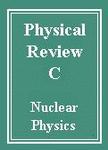版权所有:内蒙古大学图书馆 技术提供:维普资讯• 智图
内蒙古自治区呼和浩特市赛罕区大学西街235号 邮编: 010021

作者机构:CAS Key Laboratory of High Precision Nuclear Spectroscopy Institute of Modern Physics Chinese Academy of Sciences Lanzhou 730000 China School of Nuclear Science and Technology Lanzhou University Lanzhou 730000 China School of Nuclear Science and Technology University of Chinese Academy of Sciences Beijing 100049 China School of Physics and Engineering Zhengzhou University Zhengzhou 450001 China Department of Physics The University of Hong Kong Hong Kong China Department of Nuclear Physics China Institute of Atomic Energy Beijing 102413 China Advanced Energy Science and Technology Guangdong Laboratory Huizhou 516003 China School of Physics and Astronomy Shanghai Jiao Tong University Shanghai 200240 China College of Physics and Technology Guangxi Normal University Guilin 541004 China Sino-French Institute of Nuclear Engineering and Technology Sun Yat-Sen University Zhuhai 519082 China State Key Laboratory of Nuclear Physics and Technology School of Physics Peking University Beijing 100871 China College of Science Huzhou University Huzhou 313000 China Shanghai Institute of Applied Physics Chinese Academy of Sciences Shanghai 201800 China Institute of Modern Physics Fudan University Shanghai 200433 China Fundamental Science on Nuclear Safety and Simulation Technology Laboratory Harbin Engineering University Harbin 150001 China Department of Physics Sardar Vallabhbhai National Institute of Technology Surat 395007 India School of Physics and Astronomy Yunnan University Kunming 650091 China School of Physical Science and Technology Southwest University Chongqing 400044 China School of Physics and Nuclear Energy Engineering Beihang University Beijing 100191 China RCNP Osaka University Osaka 567-0047 Japan Joint Department for Nuclear Physics Lanzhou University and Institute of Modern Physics CAS Lanzhou 730000 China
出 版 物:《Physical Review C》 (物理学评论C辑:核物理学)
年 卷 期:2021年第103卷第6期
页 面:L061301-L061301页
核心收录:
学科分类:07[理学] 070202[理学-粒子物理与原子核物理] 0702[理学-物理学]
基 金:National Key R&D Programs, (2016YFA0400503, 2018YFA0404404) National Natural Science Foundation of China, NSFC, (11490562, 11635015, 11675229, 11705244, 11705285, 11775277, 11775316, 11805120, 11805280, 11825504, U1432246, U1632136, U1732145, U1867212, U1932206, WDJC-2019-13) National Natural Science Foundation of China, NSFC Chinese Academy of Sciences, CAS, (XDB34010300) Chinese Academy of Sciences, CAS Ministry of Science and Technology of the People's Republic of China, MOST
主 题:Beta decay Lifetimes & widths Nuclear structure & decays Proton emission 20 ≤ A ≤ 38
摘 要:The β-delayed two-proton (β2p) decay of S27 was studied using a state-of-the-art silicon array and Clover-type HPGe detectors. An energy peak at 6372(15) keV with a branching ratio of 2.4(5)% in the decay-energy spectrum was identified as a two-proton transition via the isobaric-analog state in P27 to the ground state of Al25 in the β decay of S27. Two-proton angular correlations were measured by the silicon array to study the mechanism of two-proton emission. Based on experimental results and Monte Carlo simulations, it was found that the main mechanism for the emission of β2p by S27 is of sequential nature.